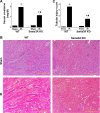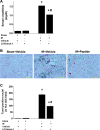Semaphorin 3A inactivation suppresses ischemia-reperfusion-induced inflammation and acute kidney injury
- PMID: 24829504
- PMCID: PMC4101625
- DOI: 10.1152/ajprenal.00177.2014
Semaphorin 3A inactivation suppresses ischemia-reperfusion-induced inflammation and acute kidney injury
Abstract
Recent studies show that guidance molecules that are known to regulate cell migration during development may also play an important role in adult pathophysiologic states. One such molecule, semaphorin3A (sema3A), is highly expressed after acute kidney injury (AKI) in mice and humans, but its pathophysiological role is unknown. Genetic inactivation of sema3A protected mice from ischemia-reperfusion-induced AKI, improved tissue histology, reduced neutrophil infiltration, prevented epithelial cell apoptosis, and increased cytokine and chemokine excretion in urine. Pharmacological-based inhibition of sema3A receptor binding likewise protected against ischemia-reperfusion-induced AKI. In vitro, sema3A enhanced toll-like receptor 4-mediated inflammation in epithelial cells, macrophages, and dendritic cells. Moreover, administration of sema3A-treated, bone marrow-derived dendritic cells exacerbated kidney injury. Finally, sema3A augmented cisplatin-induced apoptosis in kidney epithelial cells in vitro via expression of DFFA-like effector a (cidea). Our data suggest that the guidance molecule sema3A exacerbates AKI via promoting inflammation and epithelial cell apoptosis.
Keywords: acute kidney injury; cisplatin; semaphorin3A.
Copyright © 2014 the American Physiological Society.
Figures










Similar articles
-
Inhibition of semaphorin-3a suppresses lipopolysaccharide-induced acute kidney injury.J Mol Med (Berl). 2018 Jul;96(7):713-724. doi: 10.1007/s00109-018-1653-6. Epub 2018 Jun 16. J Mol Med (Berl). 2018. PMID: 29909462
-
Gpr97 Exacerbates AKI by Mediating Sema3A Signaling.J Am Soc Nephrol. 2018 May;29(5):1475-1489. doi: 10.1681/ASN.2017080932. Epub 2018 Mar 12. J Am Soc Nephrol. 2018. PMID: 29531097 Free PMC article.
-
Trehalose attenuates renal ischemia-reperfusion injury by enhancing autophagy and inhibiting oxidative stress and inflammation.Am J Physiol Renal Physiol. 2020 Apr 1;318(4):F994-F1005. doi: 10.1152/ajprenal.00568.2019. Epub 2020 Feb 18. Am J Physiol Renal Physiol. 2020. PMID: 32068461
-
Cell Death in the Kidney.Int J Mol Sci. 2019 Jul 23;20(14):3598. doi: 10.3390/ijms20143598. Int J Mol Sci. 2019. PMID: 31340541 Free PMC article. Review.
-
[The role of macrophage polarization and interaction with renal tubular epithelial cells in ischemia-reperfusion induced acute kidney injury].Sheng Li Xue Bao. 2022 Feb 25;74(1):28-38. Sheng Li Xue Bao. 2022. PMID: 35199123 Review. Chinese.
Cited by
-
Urinary semaphorin 3A as an early biomarker to predict contrast-induced acute kidney injury in patients undergoing percutaneous coronary intervention.Braz J Med Biol Res. 2018 Mar 1;51(4):e6487. doi: 10.1590/1414-431X20176487. Braz J Med Biol Res. 2018. PMID: 29513790 Free PMC article.
-
Semaphorin3A elevates vascular permeability and contributes to cerebral ischemia-induced brain damage.Sci Rep. 2015 Jan 20;5:7890. doi: 10.1038/srep07890. Sci Rep. 2015. PMID: 25601765 Free PMC article.
-
Semaphorin3A-Inhibitor Ameliorates Doxorubicin-Induced Podocyte Injury.Int J Mol Sci. 2020 Jun 8;21(11):4099. doi: 10.3390/ijms21114099. Int J Mol Sci. 2020. PMID: 32521824 Free PMC article.
-
Delayed Contralateral Nephrectomy Halted Post-Ischemic Renal Fibrosis Progression and Inhibited the Ischemia-Induced Fibromir Upregulation in Mice.Biomedicines. 2021 Jul 14;9(7):815. doi: 10.3390/biomedicines9070815. Biomedicines. 2021. PMID: 34356879 Free PMC article.
-
Inhibition of semaphorin-3a suppresses lipopolysaccharide-induced acute kidney injury.J Mol Med (Berl). 2018 Jul;96(7):713-724. doi: 10.1007/s00109-018-1653-6. Epub 2018 Jun 16. J Mol Med (Berl). 2018. PMID: 29909462
References
-
- Bagri A, Marin O, Plump AS, Mak J, Pleasure SJ. Slit proteins prevent midline crossing and determine the dorsoventral position of major axonal pathways in the mammalian forebrain. Neuron 33: 233–248, 2002 - PubMed
-
- Behar O, Golden JA, Mashimo H, Schoen FJ, Fishman MC. Semaphorin III is needed for normal patterning and growth of nerves, bones and heart. Nature 383: 525–528, 1996 - PubMed
-
- Bellomo R, Ronco C, Kellum JA, Mehta RL, Palevsky P. Acute renal failure–definition, outcome measures, animal models, fluid therapy and information technology needs: the Second International Consensus Conference of the Acute Dialysis Quality Initiative (ADQI) Group. Crit Care 8: R204–R212, 2004 - PMC - PubMed
-
- Bielenberg DR, Klagsbrun M. Targeting endothelial and tumor cells with semaphorins. Cancer Metastasis Rev 26: 421–431, 2007 - PubMed
-
- Bonventre JV, Zuk A. Ischemic acute renal failure: an inflammatory disease? Kidney Int 66: 480–485, 2004 - PubMed
Publication types
MeSH terms
Substances
Grants and funding
LinkOut - more resources
Full Text Sources
Other Literature Sources
Molecular Biology Databases

